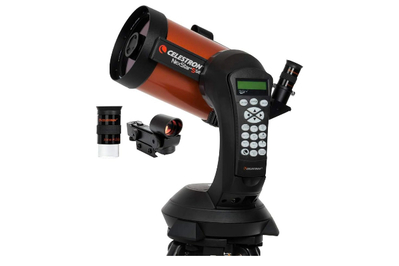The 5 Best Telescopes for Beginners of 2025

Top pick
The Celestron NexStar 5SE Computerized Telescope, a Schmidt-Cassegrain model, is our top pick due to its superior ease of use and solid image quality. Its primary 5-inch mirror offers crisp, intimate views of the moon and bright planets, and it provides an entry into views of distant galaxies and star clusters.
It’s fully computerized. The NexStar 5SE comes with a handheld controller to guide the telescope across the sky. Compared with our experience using some competing models, we found that this controller worked seamlessly, offering micro adjustments and responsive tracking with the attached controller system.
It provides the best balance between functionality and size. We chose the NexStar 5SE as the best telescope for most beginners because of its size, functionality, and cost. The telescope and the included tripod together weigh about 27 pounds and easily disassemble into several portable pieces.
Since we were looking for portability, we set aside the larger models in the same product line, and we dismissed the smaller NexStar 4SE due to its more-limited capacity to offer views of deep-sky objects.
If size is not an issue for you, we recommend upgrading to the NexStar 6SE, since an extra inch of aperture opens up more light-gathering potential and thus more viewing opportunities.
The NexStar 5SE comes with a 25mm eyepiece, a great first option before you expand into more-specialized eyepieces.
The computerized mount makes finding stars easy. This can help speed up the learning process and assist novices in navigating the endless sea of stars without their having to commit years to accumulating that kind of knowledge. (If you want to learn the old-fashioned way, a great resource for the whole family is The Stars: A New Way to See Them, an astronomy how-to written by H.A. Rey, the creator of Curious George.)
Note that you can control this telescope only with its controller, so you should be comfortable pressing buttons and reading a small screen instead of pushing the optical tube into position.
It comes with a database of targets to look at. When you enter information such as the date, the time, and the nearest city to your observing site, the NexStar 5SE offers a database of nearly 40,000 nighttime objects.
This database allows you to identify objects you see through the scope, as well as to instruct the telescope to find new objects. The Tour feature offers a list of the best objects to view specific to your time and location, anywhere in the world.
It’s easy to set up and use. Along with an extensive owner manual, the NexStar 5SE comes with an expedited and abridged setup manual, replete with instructional photos intended to get you using your telescope as fast as possible.
Using these friendly instructions, we had the telescope mounted and set up in under 15 minutes (you need to tighten some screws, but most pieces snap together), and we were already playing with the SkyAlign telescope-alignment features. The telescope comes with an adjustable tripod, which makes it easy to use whether you’re sitting down or standing up.
The included accessories are excellent. The NexStar 5SE includes a 25mm eyepiece, which serves as the best starter eyepiece to expand upon later. It also comes with an ultra-sturdy steel tripod, and you can attach the optical tube without having to use tools. The NexStar 5SE’s tripod (but not that of the 6SE or the 8SE) also includes a wedge for adjusting the mount and allowing for some tinkering in longer-exposure astrophotography.
Flaws but not dealbreakers
- It runs on eight AA batteries, and they drain fast. The batteries power the mount, and when it’s in use they offer an average of only two to four hours of power. Other power sources are available, however, including this AC adapter from Celestron. You can also draw power from your car battery and a portable 12 V DC power supply. Celestron sells an accessory called a Power Tank for use in the field, but we haven’t tested it ourselves. If you’d like a rechargeable option, check out our favorite portable power stations.







